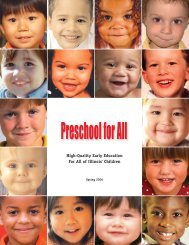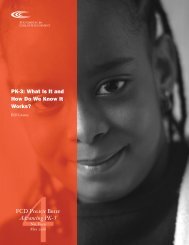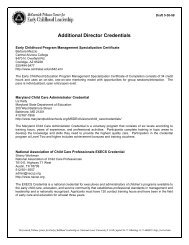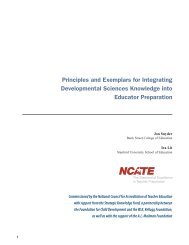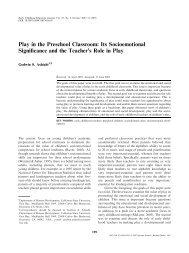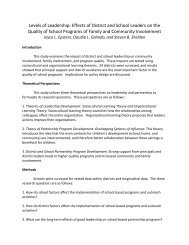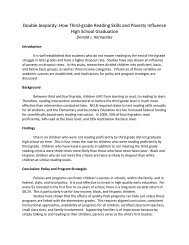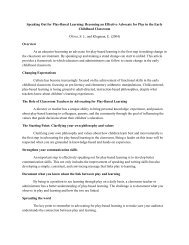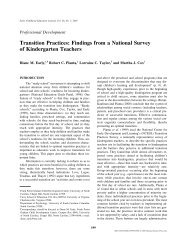Child Outcome Standards in Pre-K Programs - National Institute for ...
Child Outcome Standards in Pre-K Programs - National Institute for ...
Child Outcome Standards in Pre-K Programs - National Institute for ...
Create successful ePaper yourself
Turn your PDF publications into a flip-book with our unique Google optimized e-Paper software.
<strong>Pre</strong>school Policy Brief March 2004Extend<strong>in</strong>g <strong>Outcome</strong> <strong>Standards</strong>to the <strong>Pre</strong>school Years<strong>Outcome</strong> standards are a relativelyrecent phenomenon <strong>in</strong> Americaneducation. For most of our nation’shistory, parents and school boardslacked the systematic assessment<strong>in</strong><strong>for</strong>mation needed to gauge children’sprogress and the effectivenessof schools. There was little agreementon what children should know andbe able to do. In recent decades,accountability took on new mean<strong>in</strong>g.State agencies and professional organizationshave engaged <strong>in</strong> major ef<strong>for</strong>tsto def<strong>in</strong>e, with some precision, theknowledge and skills that students areexpected to master at each grade leveland <strong>in</strong> each subject area. Curriculaand assessments have been alignedwith these standards. And <strong>in</strong> manycases, schools and pr<strong>in</strong>cipals havebeen rated on the basis of theirability to meet the standards.Researchers say that the ef<strong>for</strong>t hasbegun to pay off. Today, ef<strong>for</strong>ts areunderway to extend that successto preschool programs. 4 The idea isto use standards to improve the oddsthat preschool programs willboost school read<strong>in</strong>ess and laya solid foundation <strong>for</strong> laterachievement.The idea rema<strong>in</strong>s controversial,however. After all, from thestandpo<strong>in</strong>t of development, 3-and 4-year-olds are differentfrom older children. <strong>Pre</strong>schoolersare actively engaged <strong>in</strong> mak<strong>in</strong>gsense of their worlds, but they havenot yet developed the strategies <strong>for</strong>process<strong>in</strong>g <strong>in</strong><strong>for</strong>mation, remember<strong>in</strong>g,and solv<strong>in</strong>g problems that mostolder children take <strong>for</strong> granted.For example, accord<strong>in</strong>g to the<strong>National</strong> Research Council, 3- and 4-year-olds are just beg<strong>in</strong>n<strong>in</strong>g to understandthe need to use strategic ef<strong>for</strong>t<strong>in</strong> order to learn. 5All children learn <strong>in</strong> the context ofimportant relationships, but <strong>in</strong> thepreschool years children’s learn<strong>in</strong>gis especially <strong>in</strong>fluenced by the social<strong>in</strong>teractions they experience, whetherat home or <strong>in</strong> other sett<strong>in</strong>gs. Scientistssay that young children’s capacities aredecisively <strong>in</strong>fluenced by their environmentsand the people who care <strong>for</strong>them. “<strong>Child</strong>ren’s curiosity andpersistence are supported by adultswho direct their attention, structuretheir experiences, support theirlearn<strong>in</strong>g attempts, and regulate thecomplexity and difficulty levels of<strong>in</strong><strong>for</strong>mation <strong>for</strong> them.” 6How can standards take <strong>in</strong>to accountthese and other f<strong>in</strong>d<strong>in</strong>gs about thedevelopment and learn<strong>in</strong>g of youngchildren? How is it possible to def<strong>in</strong>ereasonable developmental milestones,assess them appropriately, and usethe <strong>in</strong><strong>for</strong>mation toimprove plann<strong>in</strong>g,classroompedagogy, andprogramevaluation?The Impact of K-12<strong>Standards</strong><strong>Standards</strong>-based re<strong>for</strong>m is a comprehensiveapproach that has <strong>in</strong>fluenced manyareas of education. 7 Accord<strong>in</strong>g to datacollected by the Education Commissionof States, “states that have focused onalign<strong>in</strong>g various components of theireducation system with standards haveshown improvement <strong>in</strong> student achievementand school quality.” 8Similar f<strong>in</strong>d<strong>in</strong>gs were reported <strong>in</strong> thenewly released longitud<strong>in</strong>al study ofat-risk children <strong>in</strong> Title 1 schools.The study found that, “students’ <strong>in</strong>itialread<strong>in</strong>g scores tended to be higher <strong>in</strong>classrooms where teachers reported theywere aware of, and implement<strong>in</strong>g,policies of standards-based re<strong>for</strong>m.” 9Given these f<strong>in</strong>d<strong>in</strong>gs, educators andparents may expect an emphasis on earlylearn<strong>in</strong>g standards to produce similarimprovements <strong>in</strong> the quality of earlychildhood programs. However, ananalysis of exist<strong>in</strong>g pre-K standardsdocuments 10 and a review of thestandards movement <strong>in</strong> general<strong>in</strong>dicate that the impact ofstandards depends upon arange of conditions, <strong>in</strong>clud<strong>in</strong>gthe policy and implementationissues addressed <strong>in</strong> these pages.3




